Effectiveness of Yoga Compared to Physical Therapy for Cancer Patients
VerifiedAdded on 2023/01/12
|6
|1350
|33
Report
AI Summary
This report investigates the effectiveness of yoga as a traditional physical therapy for reducing lymphedema in patients who have undergone treatment for head and neck cancer. It begins with an introduction outlining the problem of lymphedema, a common side effect of cancer treatment, and the potential benefits of yoga as an intervention. The report's aim is to determine the effectiveness of yoga in reducing lymphedema. The objectives include identifying the concept of yoga as physical therapy, determining its advantages in head and neck cancer treatment, and measuring its effect on patients' quality of life. The significance of the study lies in its potential to guide yoga trainers and contribute to a safe environment for cancer patients. The literature review explores the concept of yoga as a physical therapy, its advantages in head and neck cancer treatment, and the methods employed. The research methodology section details the qualitative approach used, including data collection through questionnaires and thematic analysis. The report also addresses limitations and potential outcomes, such as measuring yoga's effect on quality of life and reducing patient stress levels. It concludes with a list of references from books and journals.
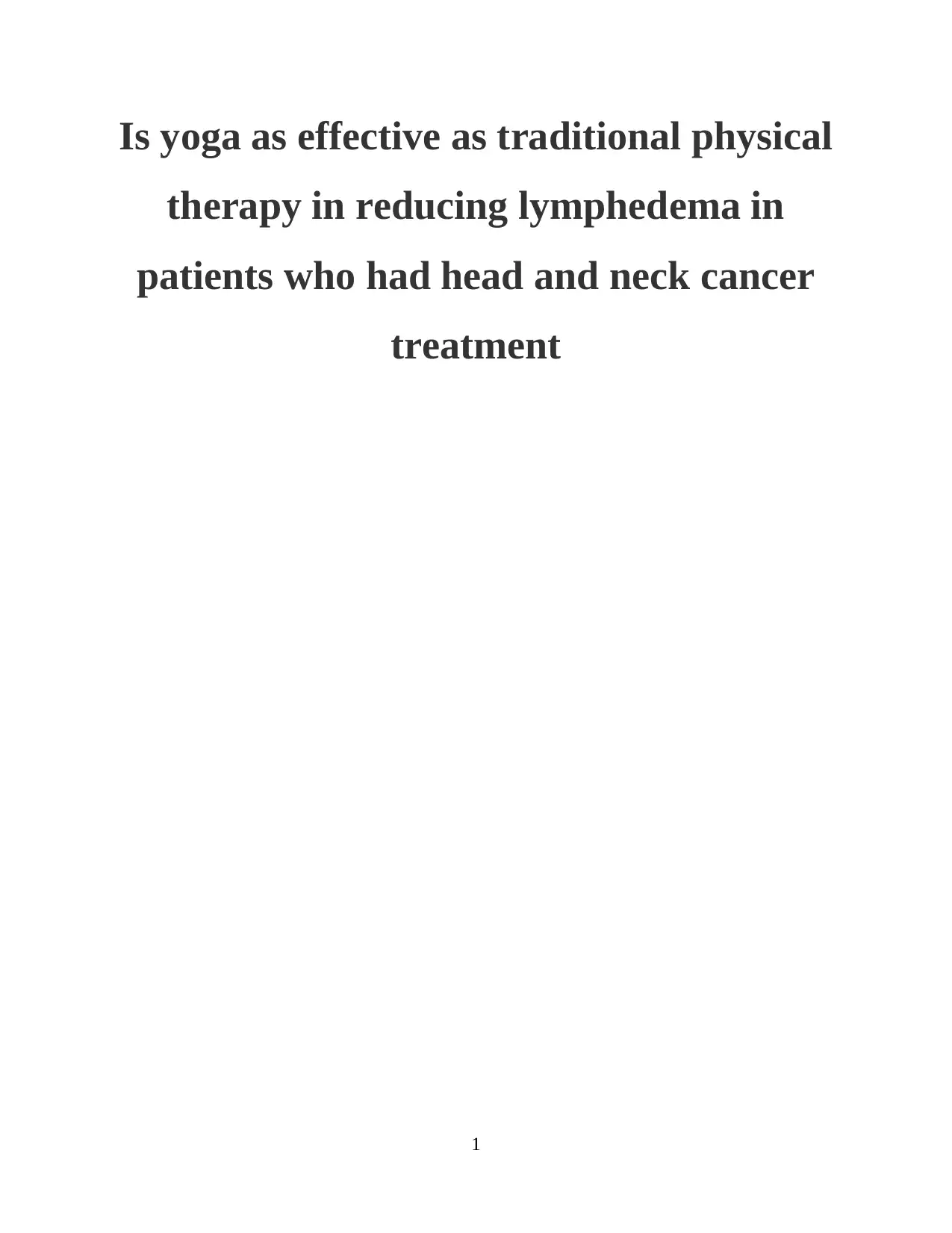
Is yoga as effective as traditional physical
therapy in reducing lymphedema in
patients who had head and neck cancer
treatment
1
therapy in reducing lymphedema in
patients who had head and neck cancer
treatment
1
Paraphrase This Document
Need a fresh take? Get an instant paraphrase of this document with our AI Paraphraser
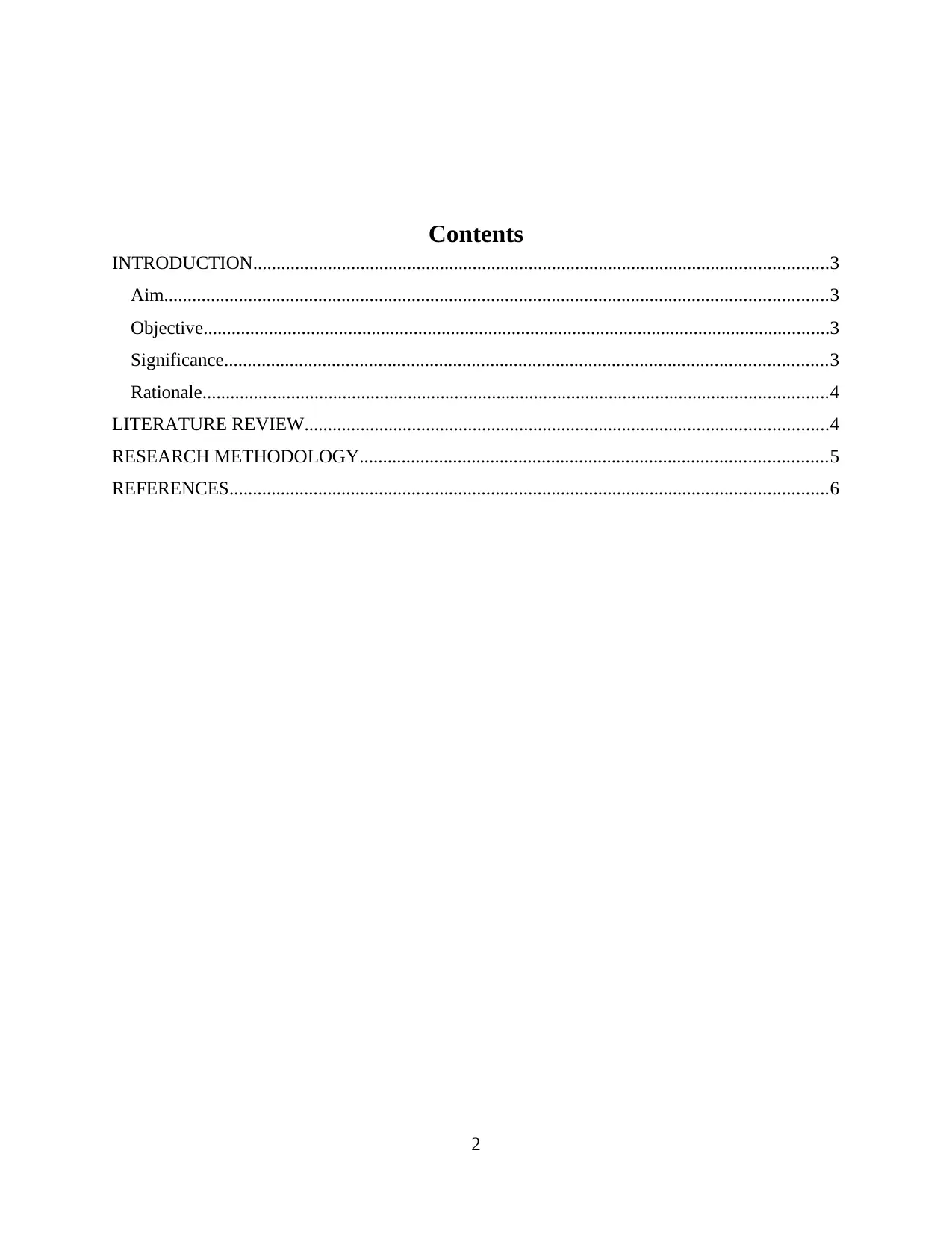
Contents
INTRODUCTION...........................................................................................................................3
Aim..............................................................................................................................................3
Objective......................................................................................................................................3
Significance.................................................................................................................................3
Rationale......................................................................................................................................4
LITERATURE REVIEW................................................................................................................4
RESEARCH METHODOLOGY....................................................................................................5
REFERENCES................................................................................................................................6
2
INTRODUCTION...........................................................................................................................3
Aim..............................................................................................................................................3
Objective......................................................................................................................................3
Significance.................................................................................................................................3
Rationale......................................................................................................................................4
LITERATURE REVIEW................................................................................................................4
RESEARCH METHODOLOGY....................................................................................................5
REFERENCES................................................................................................................................6
2
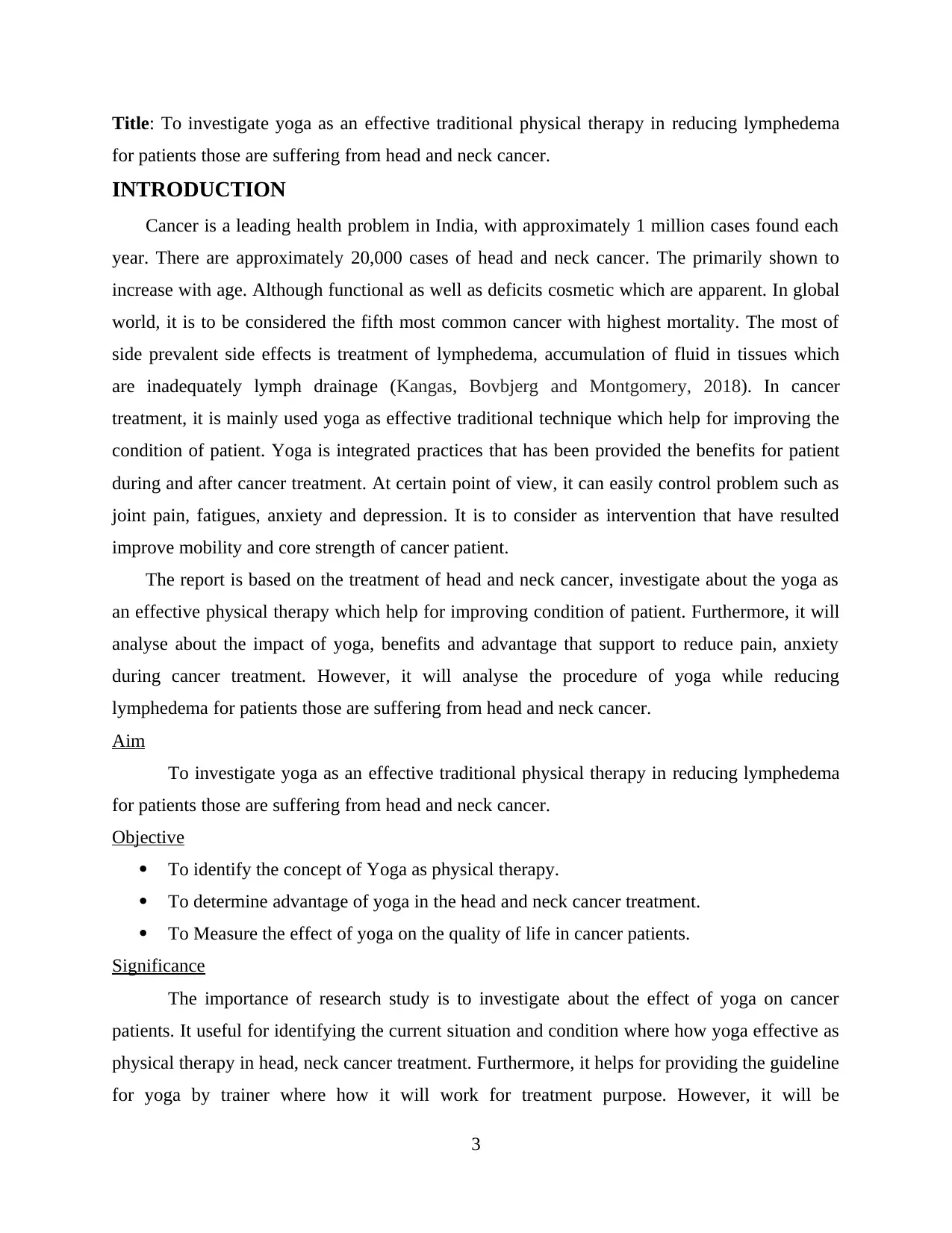
Title: To investigate yoga as an effective traditional physical therapy in reducing lymphedema
for patients those are suffering from head and neck cancer.
INTRODUCTION
Cancer is a leading health problem in India, with approximately 1 million cases found each
year. There are approximately 20,000 cases of head and neck cancer. The primarily shown to
increase with age. Although functional as well as deficits cosmetic which are apparent. In global
world, it is to be considered the fifth most common cancer with highest mortality. The most of
side prevalent side effects is treatment of lymphedema, accumulation of fluid in tissues which
are inadequately lymph drainage (Kangas, Bovbjerg and Montgomery, 2018). In cancer
treatment, it is mainly used yoga as effective traditional technique which help for improving the
condition of patient. Yoga is integrated practices that has been provided the benefits for patient
during and after cancer treatment. At certain point of view, it can easily control problem such as
joint pain, fatigues, anxiety and depression. It is to consider as intervention that have resulted
improve mobility and core strength of cancer patient.
The report is based on the treatment of head and neck cancer, investigate about the yoga as
an effective physical therapy which help for improving condition of patient. Furthermore, it will
analyse about the impact of yoga, benefits and advantage that support to reduce pain, anxiety
during cancer treatment. However, it will analyse the procedure of yoga while reducing
lymphedema for patients those are suffering from head and neck cancer.
Aim
To investigate yoga as an effective traditional physical therapy in reducing lymphedema
for patients those are suffering from head and neck cancer.
Objective
To identify the concept of Yoga as physical therapy.
To determine advantage of yoga in the head and neck cancer treatment.
To Measure the effect of yoga on the quality of life in cancer patients.
Significance
The importance of research study is to investigate about the effect of yoga on cancer
patients. It useful for identifying the current situation and condition where how yoga effective as
physical therapy in head, neck cancer treatment. Furthermore, it helps for providing the guideline
for yoga by trainer where how it will work for treatment purpose. However, it will be
3
for patients those are suffering from head and neck cancer.
INTRODUCTION
Cancer is a leading health problem in India, with approximately 1 million cases found each
year. There are approximately 20,000 cases of head and neck cancer. The primarily shown to
increase with age. Although functional as well as deficits cosmetic which are apparent. In global
world, it is to be considered the fifth most common cancer with highest mortality. The most of
side prevalent side effects is treatment of lymphedema, accumulation of fluid in tissues which
are inadequately lymph drainage (Kangas, Bovbjerg and Montgomery, 2018). In cancer
treatment, it is mainly used yoga as effective traditional technique which help for improving the
condition of patient. Yoga is integrated practices that has been provided the benefits for patient
during and after cancer treatment. At certain point of view, it can easily control problem such as
joint pain, fatigues, anxiety and depression. It is to consider as intervention that have resulted
improve mobility and core strength of cancer patient.
The report is based on the treatment of head and neck cancer, investigate about the yoga as
an effective physical therapy which help for improving condition of patient. Furthermore, it will
analyse about the impact of yoga, benefits and advantage that support to reduce pain, anxiety
during cancer treatment. However, it will analyse the procedure of yoga while reducing
lymphedema for patients those are suffering from head and neck cancer.
Aim
To investigate yoga as an effective traditional physical therapy in reducing lymphedema
for patients those are suffering from head and neck cancer.
Objective
To identify the concept of Yoga as physical therapy.
To determine advantage of yoga in the head and neck cancer treatment.
To Measure the effect of yoga on the quality of life in cancer patients.
Significance
The importance of research study is to investigate about the effect of yoga on cancer
patients. It useful for identifying the current situation and condition where how yoga effective as
physical therapy in head, neck cancer treatment. Furthermore, it helps for providing the guideline
for yoga by trainer where how it will work for treatment purpose. However, it will be
3
⊘ This is a preview!⊘
Do you want full access?
Subscribe today to unlock all pages.

Trusted by 1+ million students worldwide
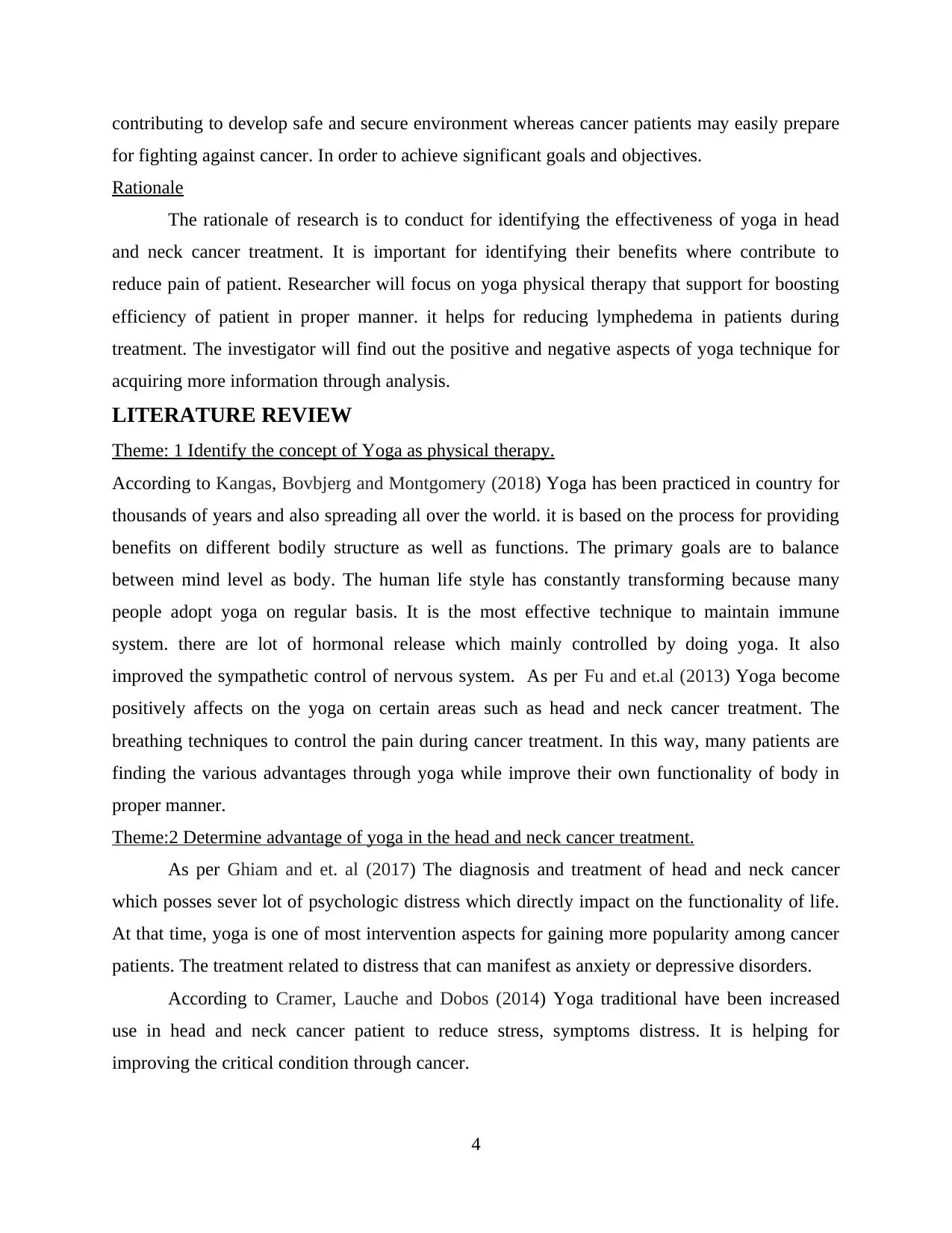
contributing to develop safe and secure environment whereas cancer patients may easily prepare
for fighting against cancer. In order to achieve significant goals and objectives.
Rationale
The rationale of research is to conduct for identifying the effectiveness of yoga in head
and neck cancer treatment. It is important for identifying their benefits where contribute to
reduce pain of patient. Researcher will focus on yoga physical therapy that support for boosting
efficiency of patient in proper manner. it helps for reducing lymphedema in patients during
treatment. The investigator will find out the positive and negative aspects of yoga technique for
acquiring more information through analysis.
LITERATURE REVIEW
Theme: 1 Identify the concept of Yoga as physical therapy.
According to Kangas, Bovbjerg and Montgomery (2018) Yoga has been practiced in country for
thousands of years and also spreading all over the world. it is based on the process for providing
benefits on different bodily structure as well as functions. The primary goals are to balance
between mind level as body. The human life style has constantly transforming because many
people adopt yoga on regular basis. It is the most effective technique to maintain immune
system. there are lot of hormonal release which mainly controlled by doing yoga. It also
improved the sympathetic control of nervous system. As per Fu and et.al (2013) Yoga become
positively affects on the yoga on certain areas such as head and neck cancer treatment. The
breathing techniques to control the pain during cancer treatment. In this way, many patients are
finding the various advantages through yoga while improve their own functionality of body in
proper manner.
Theme:2 Determine advantage of yoga in the head and neck cancer treatment.
As per Ghiam and et. al (2017) The diagnosis and treatment of head and neck cancer
which posses sever lot of psychologic distress which directly impact on the functionality of life.
At that time, yoga is one of most intervention aspects for gaining more popularity among cancer
patients. The treatment related to distress that can manifest as anxiety or depressive disorders.
According to Cramer, Lauche and Dobos (2014) Yoga traditional have been increased
use in head and neck cancer patient to reduce stress, symptoms distress. It is helping for
improving the critical condition through cancer.
4
for fighting against cancer. In order to achieve significant goals and objectives.
Rationale
The rationale of research is to conduct for identifying the effectiveness of yoga in head
and neck cancer treatment. It is important for identifying their benefits where contribute to
reduce pain of patient. Researcher will focus on yoga physical therapy that support for boosting
efficiency of patient in proper manner. it helps for reducing lymphedema in patients during
treatment. The investigator will find out the positive and negative aspects of yoga technique for
acquiring more information through analysis.
LITERATURE REVIEW
Theme: 1 Identify the concept of Yoga as physical therapy.
According to Kangas, Bovbjerg and Montgomery (2018) Yoga has been practiced in country for
thousands of years and also spreading all over the world. it is based on the process for providing
benefits on different bodily structure as well as functions. The primary goals are to balance
between mind level as body. The human life style has constantly transforming because many
people adopt yoga on regular basis. It is the most effective technique to maintain immune
system. there are lot of hormonal release which mainly controlled by doing yoga. It also
improved the sympathetic control of nervous system. As per Fu and et.al (2013) Yoga become
positively affects on the yoga on certain areas such as head and neck cancer treatment. The
breathing techniques to control the pain during cancer treatment. In this way, many patients are
finding the various advantages through yoga while improve their own functionality of body in
proper manner.
Theme:2 Determine advantage of yoga in the head and neck cancer treatment.
As per Ghiam and et. al (2017) The diagnosis and treatment of head and neck cancer
which posses sever lot of psychologic distress which directly impact on the functionality of life.
At that time, yoga is one of most intervention aspects for gaining more popularity among cancer
patients. The treatment related to distress that can manifest as anxiety or depressive disorders.
According to Cramer, Lauche and Dobos (2014) Yoga traditional have been increased
use in head and neck cancer patient to reduce stress, symptoms distress. It is helping for
improving the critical condition through cancer.
4
Paraphrase This Document
Need a fresh take? Get an instant paraphrase of this document with our AI Paraphraser
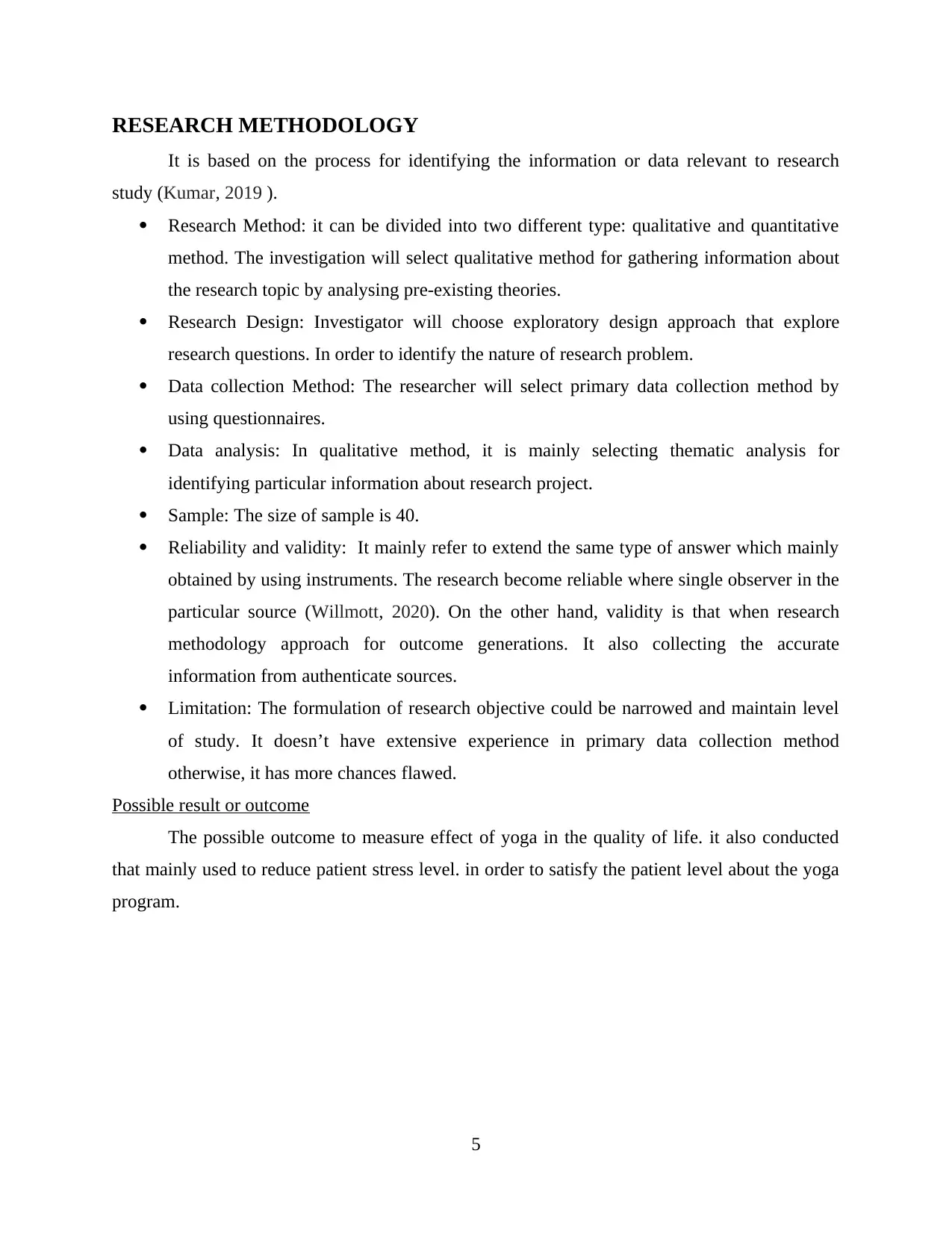
RESEARCH METHODOLOGY
It is based on the process for identifying the information or data relevant to research
study (Kumar, 2019 ).
Research Method: it can be divided into two different type: qualitative and quantitative
method. The investigation will select qualitative method for gathering information about
the research topic by analysing pre-existing theories.
Research Design: Investigator will choose exploratory design approach that explore
research questions. In order to identify the nature of research problem.
Data collection Method: The researcher will select primary data collection method by
using questionnaires.
Data analysis: In qualitative method, it is mainly selecting thematic analysis for
identifying particular information about research project.
Sample: The size of sample is 40.
Reliability and validity: It mainly refer to extend the same type of answer which mainly
obtained by using instruments. The research become reliable where single observer in the
particular source (Willmott, 2020). On the other hand, validity is that when research
methodology approach for outcome generations. It also collecting the accurate
information from authenticate sources.
Limitation: The formulation of research objective could be narrowed and maintain level
of study. It doesn’t have extensive experience in primary data collection method
otherwise, it has more chances flawed.
Possible result or outcome
The possible outcome to measure effect of yoga in the quality of life. it also conducted
that mainly used to reduce patient stress level. in order to satisfy the patient level about the yoga
program.
5
It is based on the process for identifying the information or data relevant to research
study (Kumar, 2019 ).
Research Method: it can be divided into two different type: qualitative and quantitative
method. The investigation will select qualitative method for gathering information about
the research topic by analysing pre-existing theories.
Research Design: Investigator will choose exploratory design approach that explore
research questions. In order to identify the nature of research problem.
Data collection Method: The researcher will select primary data collection method by
using questionnaires.
Data analysis: In qualitative method, it is mainly selecting thematic analysis for
identifying particular information about research project.
Sample: The size of sample is 40.
Reliability and validity: It mainly refer to extend the same type of answer which mainly
obtained by using instruments. The research become reliable where single observer in the
particular source (Willmott, 2020). On the other hand, validity is that when research
methodology approach for outcome generations. It also collecting the accurate
information from authenticate sources.
Limitation: The formulation of research objective could be narrowed and maintain level
of study. It doesn’t have extensive experience in primary data collection method
otherwise, it has more chances flawed.
Possible result or outcome
The possible outcome to measure effect of yoga in the quality of life. it also conducted
that mainly used to reduce patient stress level. in order to satisfy the patient level about the yoga
program.
5
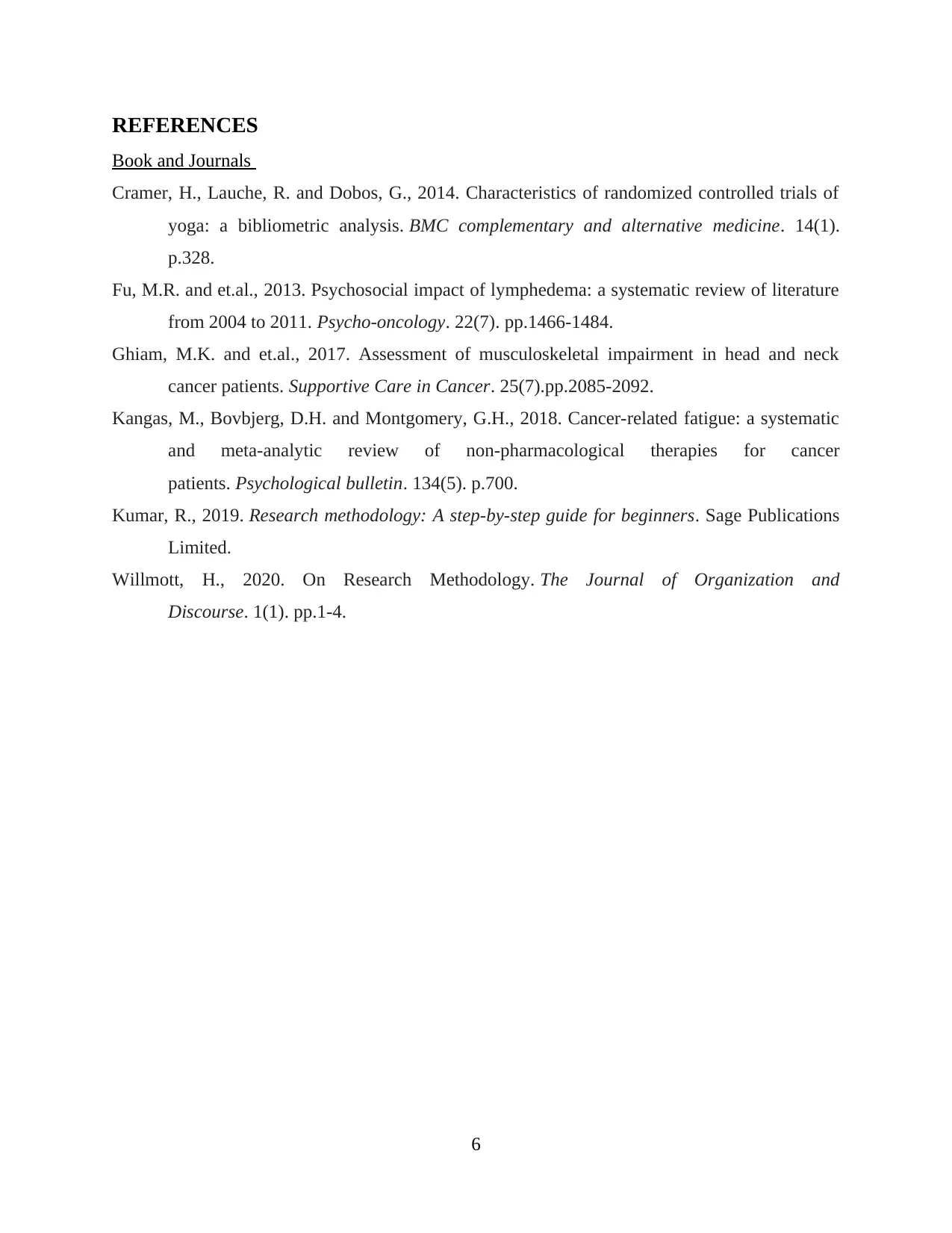
REFERENCES
Book and Journals
Cramer, H., Lauche, R. and Dobos, G., 2014. Characteristics of randomized controlled trials of
yoga: a bibliometric analysis. BMC complementary and alternative medicine. 14(1).
p.328.
Fu, M.R. and et.al., 2013. Psychosocial impact of lymphedema: a systematic review of literature
from 2004 to 2011. Psycho‐oncology. 22(7). pp.1466-1484.
Ghiam, M.K. and et.al., 2017. Assessment of musculoskeletal impairment in head and neck
cancer patients. Supportive Care in Cancer. 25(7).pp.2085-2092.
Kangas, M., Bovbjerg, D.H. and Montgomery, G.H., 2018. Cancer-related fatigue: a systematic
and meta-analytic review of non-pharmacological therapies for cancer
patients. Psychological bulletin. 134(5). p.700.
Kumar, R., 2019. Research methodology: A step-by-step guide for beginners. Sage Publications
Limited.
Willmott, H., 2020. On Research Methodology. The Journal of Organization and
Discourse. 1(1). pp.1-4.
6
Book and Journals
Cramer, H., Lauche, R. and Dobos, G., 2014. Characteristics of randomized controlled trials of
yoga: a bibliometric analysis. BMC complementary and alternative medicine. 14(1).
p.328.
Fu, M.R. and et.al., 2013. Psychosocial impact of lymphedema: a systematic review of literature
from 2004 to 2011. Psycho‐oncology. 22(7). pp.1466-1484.
Ghiam, M.K. and et.al., 2017. Assessment of musculoskeletal impairment in head and neck
cancer patients. Supportive Care in Cancer. 25(7).pp.2085-2092.
Kangas, M., Bovbjerg, D.H. and Montgomery, G.H., 2018. Cancer-related fatigue: a systematic
and meta-analytic review of non-pharmacological therapies for cancer
patients. Psychological bulletin. 134(5). p.700.
Kumar, R., 2019. Research methodology: A step-by-step guide for beginners. Sage Publications
Limited.
Willmott, H., 2020. On Research Methodology. The Journal of Organization and
Discourse. 1(1). pp.1-4.
6
⊘ This is a preview!⊘
Do you want full access?
Subscribe today to unlock all pages.

Trusted by 1+ million students worldwide
1 out of 6
Related Documents
Your All-in-One AI-Powered Toolkit for Academic Success.
+13062052269
info@desklib.com
Available 24*7 on WhatsApp / Email
![[object Object]](/_next/static/media/star-bottom.7253800d.svg)
Unlock your academic potential
Copyright © 2020–2025 A2Z Services. All Rights Reserved. Developed and managed by ZUCOL.





